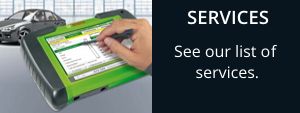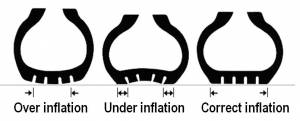Car Servicing
Electronic Tune-ups
Brake Repairs
Disc/Drum Machining
Brake Hose Manufacture
Clutch Repairs
CV Joints & Shafts
EFI Service/Diagnostics
Exhaust Repairs
Engine Analysis/Emissions Testing
Electrical Systems
Vehicle Tips

Have your vehicle serviced regularly
Service schedules vary from vehicle to vehicle, but it is recommended that you have a minor service carried out about every 5,000kms or 6 months. This involves replacing the oil and oil filter and a general check-over of the vehicle. A major service includes a tune-up of your vehicle's engine. The full service recommendations for your vehicle are stated in your Owner's Handbook and should always be followed. Before setting out on any long trip, ensure your vehicle is thoroughly checked over by a qualified Technician. Regular servicing and tuning ensures that your vehicle is maintained in peak condition, thus extending the life of your vehicle and preventing expensive repairs due to poor maintenance. A well-maintained vehicle will run more economically and major repairs could be avoided altogether. Regular servicing with a stamped service book, clearly identifying the vehicle has been well cared for, will provide a strong selling point and protect the resale value of your vehicle.
Things that you must do
- Check and top up under-bonnet fluids regularly. When your engine is cool, check your oil and water levels. Engine coolant, brake fluid and windscreen washer fluid are usually in translucent containers to allow a quick visual check. These should be checked daily if going on a long trip. If the levels drop significantly or require topping up frequently, have the vehicle checked by a qualified Technician. Remember to check under your vehicle for any signs of leaks as this could indicate your vehicle is leaking oil. We can assist you in identifying or demonstrating how these checks are carried out, or refer to your Owner's Manual for detailed instructions.
- Check your tyre pressures and condition (only when cold). Remember to also check your spare tyre. Under-inflated tyres reduce stability, accelerate tyre wear and may lead to accidents. Regularly examine the tyre surface for cuts, foreign bodies or uneven wear. Uneven wear could indicate your vehicle requires a Wheel Alignment. All tyres should be in good condition with no less than 1.55mm of tread and no cracks or abnormal wear. We recommend you rotate your tyres every 10,000km.
- When driving, always keep a close eye or your gauges and/or lights. If a dash warning light comes on, stop and have your vehicle examined by a qualified Technician. An engine that is running too hot will overheat causing engine damage which can be costly to repair.
- Take notice if you experience a reduction in brake effectiveness such as a spongy brake pedal, an increase in stopping distances, a grinding noise, or your vehicle pulls sideways. Arrange to have your brakes inspected by a qualified Technician immediately. If your handbrake does not work on a slight incline, it is best to have your braking system checked as soon as possible.
- Maintain your fuel level. On late model fuel injected cars, or any vehicle, it is advisable not to let the fuel run too low as this could cause damage to the fuel pump. Always maintain a reasonable fuel level to avoid condensation occurring in the fuel tank, which can introduce contamination into the fuel.
Wash your Car
Regular washing of your vehicle will help maintain the condition of the paintwork. Hand washing is best, but only use a mild detergent. A dirty surface accelerates the absorption of the sun's rays causing the paintwork to loose its lustre and develop a chalky appearance. A well-presented vehicle with sparkling paintwork has the potential to save you thousands of dollars in resale value.
Some Safety Issues
- Air Bags If your vehicle is fitted with airbags, it is important to remember that drivers should be at least 25cm away from the steering wheel. If you are too close, an inflating airbag could seriously injure you. Never place objects in front of you while you are seated in the front seat as injury may result when the object is forced towards you by the inflating air bag. Do not lean over the glove box or rest your feet on the dash when the vehicle is moving. Always wear your seatbelt. It is required by law and will help keep you in the correct position when the airbag inflates.
- Loose Items Any loose item in your car could become a deadly hazard in an accident situation. If you are forced to brake suddenly, loose items can catapult from one end of the vehicle to the other, causing injury to anyone in the way. Place heavy objects in the boot, or for station wagons, ensure they are securely tied down or use an approved fitted barrier.
- Jump starting Jump starting can be dangerous if done incorrectly. If you are uncertain about the correct method, it is recommended you leave the starting to a competent Technician. Batteries contain sulfuric acid which can burn skin, eyes and clothing. Remember to keep sparks, flames and lit cigarettes away from the battery at all times.
- Mobile Phones Do not use your mobile phone when refuelling. Fuel vapours and mobile phones can be extremely dangerous. Avoid igniting the fuel and suffering serious burns by keeping your mobile phone switched off when filling up with petrol.
Driving Hints
- Ensure you adopt an ergonomic position when driving. Move the seat back and forward until you can comfortably reach the pedals. Adjust the angle of the seat so that it does not cut into your legs. Make sure you have plenty of lumbar support by adjusting the back of the seat or use a rolled up towel behind the small of your back for greater comfort. Your hands should be placed on the steering wheel at the quarter past nine position. The head restraint should be centred on the back of your head (not your neck) for optimum head restraint in the event of an impact. Poor driver position can lead to aches in the back, neck and thighs, particularly after a long trip.
- Wet brakes have lower braking efficiency. When leaving a car wash, driving in heavy rain or through water, apply the brake pedal gently to dry the brakes. Allow extra stopping distance and reduce speed on wet roads.
- Before driving in sub-zero temperatures, ensure that sufficient anti-freeze protection has been added to your vehicle's cooling system. When hazardous conditions such as snow, ice or mud are encountered, drive cautiously allowing extra distance for braking. Avoid sudden steering movements and brake lightly.
- To improve the fuel economy of your vehicle, always drive at steady speeds and avoid the use of full throttle. Keep your tyres inflated to the correct pressure and have your vehicle serviced regularly. It is helpful to try to anticipate traffic conditions ahead and slow down gradually.
- If you have an Anti-lock Braking System (ABS) you should familiarise yourself with this braking technique. When braking in emergencies, apply full force to the brake pedal and steer around the obstacle. With ABS, no matter how hard you brake, steering is maintained.
When planning for a trip, the following basic safety checks and essential car maintenance should be completed...
- Check all exterior lights are working.
- Check that all glass surfaces (including mirrors) are clean and free from chips, cracks and scratches.
- Check that the windscreen wipers and washers operate efficiently.
- Check that the wiper rubbers are secure and in good condition.
- Make sure the horn works.
- Test the handbrake to ensure it “holds” on a steep hill.
- Check the condition of seat belts: make sure webbing is not worn, visibly damaged or sun bleached. Give the belt a sharp tug to make sure that it will lock.
- Check tyre pressure, tyre condition and tread depth of all tyres including the spare.
- Check engine oil levels.
- Check the radiator coolant levels.
- Check automatic transmission and power steering fluids.
- Check your brakes and have any grinding or squeaking noises investigated.
- Check your wheels.
- Check your inside controls are working.
- Ensure your car is regularly serviced and all details recorded in your log book.
Tyre Safety
Ensuring your tyres are in good condition is integral to protecting your safety on the road. Tyres are the only thing connecting your vehicle to the road and your safety, comfort and fuel economy all depend on a patch of rubber the size of your hand.
What can you do?
Check for tyre wear and tread depth...
A quick and easy safety measure is to regularly check the tread depth of your tyres and replace them when they are worn. This is done by checking the tyres' tread wear indicators which are small bars spaced across the grooves of the tread pattern. Replace tyres when the tread level reaches the minimum legal tread of 1.55mm. This will guarantee maximum traction and grip, helping to avoid any unpleasant surprises.
A good level of tread depth is important because:
- The tread disperses water from underneath your tyre, helping to maintain control.
- The tread grips to the road affecting the distance you require for braking.
- The more tread you have on your tyres, the more you reduce the risk of acquaplaning.
- Correct air pressure and vehicle maintenance will ensure your tyres perform their best for the longest possible time.
The importance of correct Tyre Pressure
- Correct inflation of tyres will optimise tyre grip on the road, improve cornering and braking, and is the safest way to drive.
- Proper tyre inflation will extend the life of your tyres, reduce fuel consumption and improve your car’s handling ability.
- Heavy loads require higher inflation pressures.
- A tyre fitted to your vehicle that is different to the original manufacturer’s tyre may require different pressure.
Check your vehicle owner’s handbook for tyre inflation pressure recommendations, or the tyre placard usually located on the driver’s door jam. Tyre inflation pressures recommended are cold inflation pressures (ie before the vehicle is driven).
Tyre pressures need to be checked about every two to four weeks. Purchase a high quality pressure gauge to accurately measure tyre pressure. Always check the pressure of your spare tyre – just in case. Remember to replace the tyre valve cap once you have checked your pressures. Wear and tread-life of a tyre depends not only on tyre inflation but also such things as road surface, wheel alignment and driving style. Remember to slow down in the wet since wet conditions will always compromise the performance of any tyre.
Other Tyre Maintenance Tips
- Check for foreign objects (eg stones, nails or glass) embedded in the tead when you check the pressure.
- Check for uneven wear - which could indicate a problem with the car's steering or suspension.
- Run your hands over the tread and sidewalls to identify any bubbles, cuts or cracks.
- Keep an eye on your tyres' tread indicators (as above)
- Rotate tyres regularly (approx every 10,000km).
- Have your tyres balanced and a wheel alignment done when having new tyres fitted to your vehicle.
Automotive Air Conditioning
If your car’s air conditioner isn’t cooling as it should, it may be losing refrigerant and require regassing.
The problem needs to be diagnosed and, if a leak is evident, must be repaired before the air conditioner is re-gassed. Topping up an air conditioner which is leaking fluorocarbon refrigerant, without first repairing the leak, is illegal.
Technicians with an ARC Automotive Air Conditioning licence will be able to advise what sort of refrigerant your car’s air conditioner uses. And only individuals with an Automotive Air Conditioning licence can legally handle fluorocarbon refrigerant in the service or repair of your car’s air conditioner.
Tips to keep your car’s air conditioner running cool include:
- Run the air conditioner for a few mintues every couple of months. This will help to keep the system lubricated and all the parts running smoothly.
- Keep the windows clsoed when your air conditioner is on.
- Have your vehicles A/C serviced regularly by a technician with an ARC Automotive Air Conditioning licence. A poorly maintained A/C can increase your fuel use costing you money.
Why is leaking refrigerant bad for the environment?
Just 1kg of fluorocarbon refrigerant leaking into the atmosphere has the same greenhouse gas impact as two tonnes of carbon dioxide. This is the equivalent of driving a family sedan for six months!
If emitted into the atmosphere, the fluorocarbon refrigerant gas contained in most air conditioners can be extremely harmful to the environment as it contributes to global warming and may damage the ozone layer. The use of fluorocarbon is regulated by the Australian Government’s Ozone Protection and Synthetic Greenhouse Gas Management Regulations 1995.
(This information provided by VASA - Association of Automotive Air conditioning, Electrical and Cooling Technicians of Australasia, 2013)
















